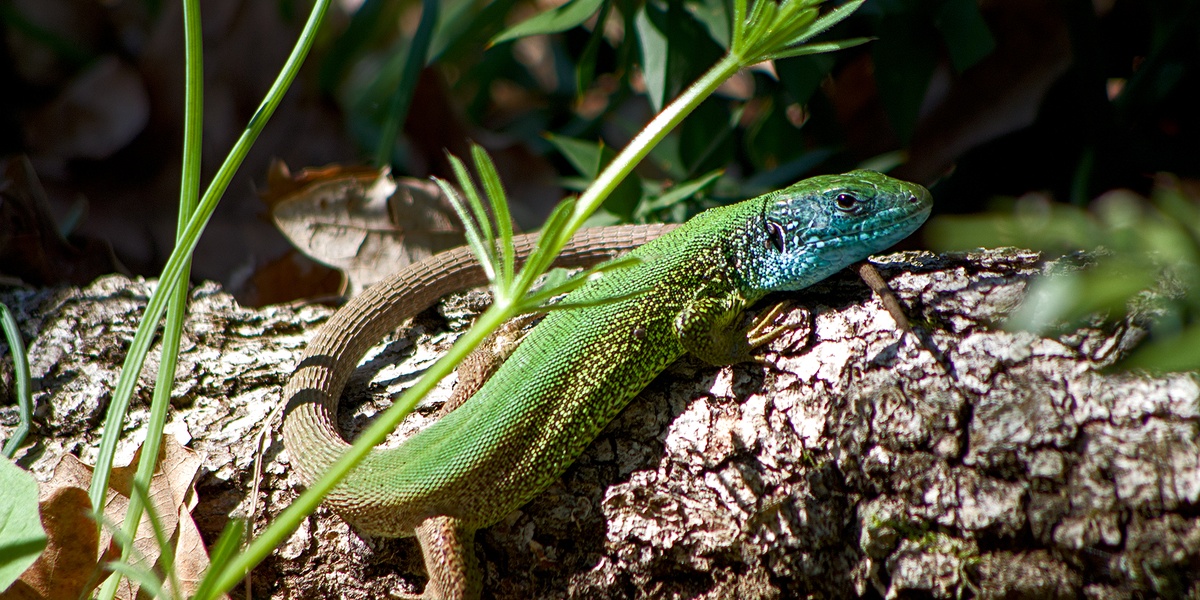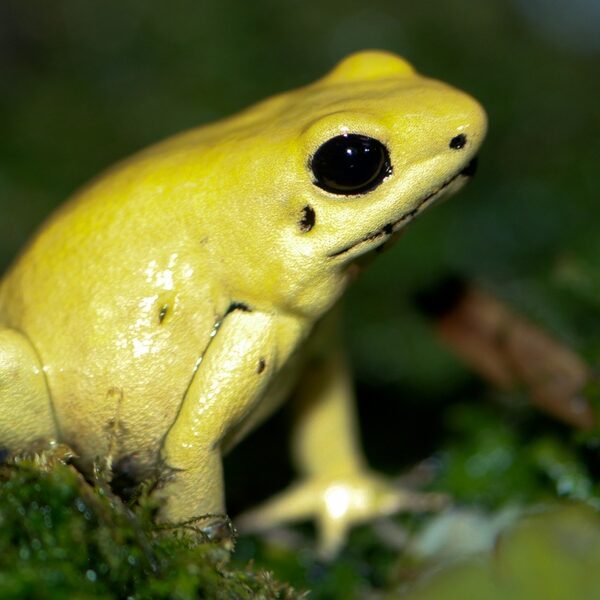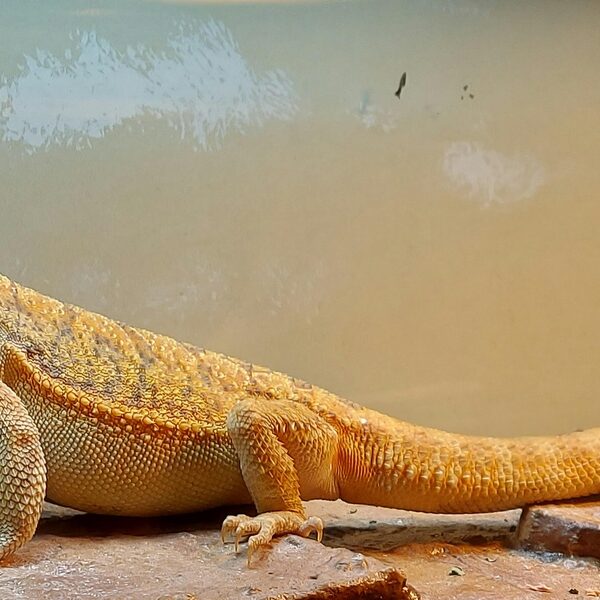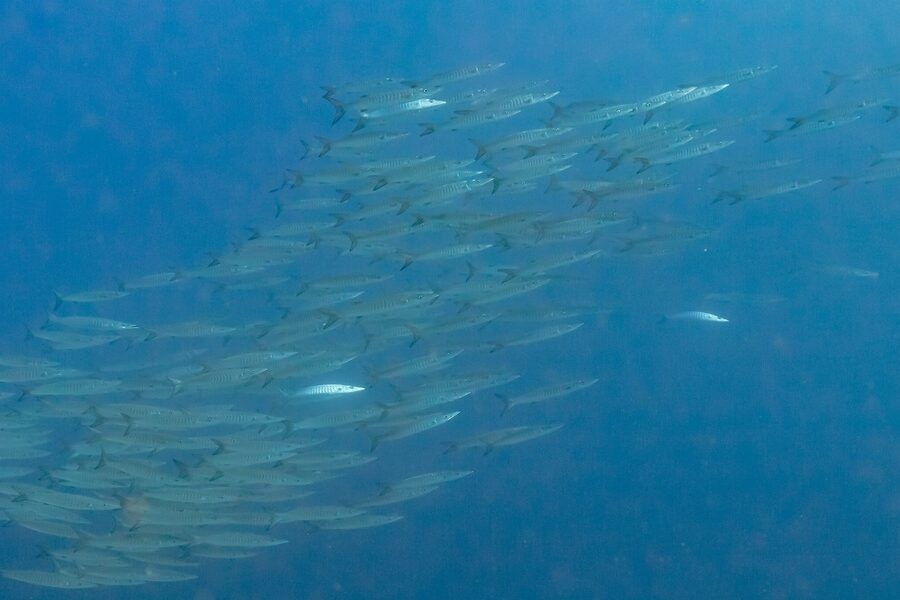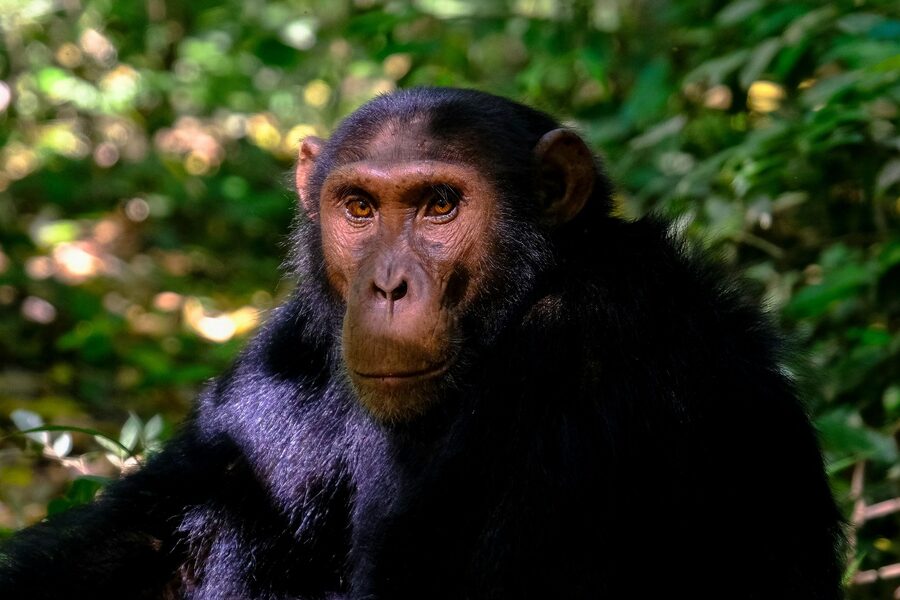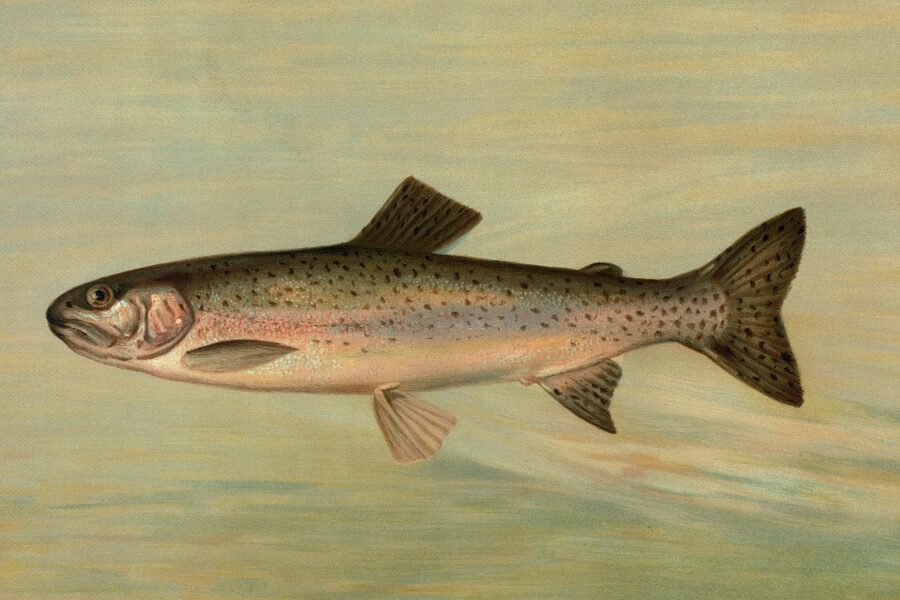Albania’s varied landscape—from Adriatic coastlines and wetlands to karst hills and high mountains—supports a surprising diversity of cold‑blooded life. Walks along riverbanks, olive groves or rocky outcrops can bring you face to face with lizards, snakes and turtles that have adapted to local microclimates and seasons.
There are 34 Reptiles of Albania, ranging from the Aesculapian snake to the Three-toed skink; for each species you’ll find below Scientific name, Max length (cm), Albania distribution, and concise notes on where they occur — you’ll find below.
Which reptiles am I most likely to see on a casual walk in Albania?
On lowland trails and near villages you’re most likely to spot wall lizards, grass snakes and small skinks basking on rocks or fence posts; snakes like the Aesculapian snake are more secretive but can appear near stone walls and ruins. Shoreline and wetland areas add turtles and water-associated species, so habitat determines sightings more than season alone.
Are any of Albania’s reptiles protected or at conservation risk?
Yes—some species face pressures from habitat loss, pollution and collection; a few are listed as threatened or Near Threatened by conservation assessments. If you’re concerned, consult the IUCN Red List and Albanian legislation for protected species and follow local guidelines to avoid disturbing habitats.
Reptiles of Albania
| Name | Scientific name | Max length (cm) | Albania distribution |
|---|---|---|---|
| European pond turtle | Emys orbicularis | 35 | Rivers, lakes, wetlands across lowlands |
| Levantine pond turtle | Mauremys rivulata | 25 | Coastal rivers and wetlands, south and central |
| Hermann’s tortoise | Testudo hermanni | 25 | Mediterranean scrub, coastal hills and oak forests |
| Spur‑thighed tortoise | Testudo graeca | 30 | Dry scrub and lowland hills, mainly south |
| Loggerhead sea turtle | Caretta caretta | 100 | Adriatic coast and nesting beaches |
| Green sea turtle | Chelonia mydas | 120 | Coastal waters, foraging near seagrass beds |
| European green lizard | Lacerta viridis | 40 | Woodland edges, river valleys, northeast areas |
| Balkan green lizard | Lacerta trilineata | 40 | Open woodland, rocky hills, widespread |
| Common wall lizard | Podarcis muralis | 20 | Urban walls, rocky outcrops, widespread |
| Italian wall lizard | Podarcis siculus | 20 | Coastal towns, ports and disturbed habitats |
| Dalmatian wall lizard | Podarcis melisellensis | 22 | Adriatic coast, islands and karst areas |
| Snake‑eyed lizard | Ophisops elegans | 18 | Dry open grassland, rocky slopes, south and lowlands |
| European glass lizard | Pseudopus apodus | 120 | Dry scrub, rocky slopes, lowland to hills |
| Slow worm | Anguis fragilis | 50 | Woodland edges, hedgerows, gardens and meadows |
| Ocellated skink | Chalcides ocellatus | 28 | Coastal dunes, scrub and sandy areas |
| Three‑toed skink | Chalcides chalcides | 30 | Sandy and shrubby coastal habitats |
| Snake‑eyed skink | Ablepharus kitaibelii | 15 | Rocky slopes, olive groves and lowland woods |
| Dalmatian algyroides | Algyroides nigropunctatus | 18 | Karst outcrops, oak forests and rocky ravines |
| Kotschy’s gecko | Mediodactylus kotschyi | 12 | Ruins, rock faces and villages, widespread |
| Mediterranean house gecko | Hemidactylus turcicus | 15 | Buildings, towns and coastal settlements |
| Grass snake | Natrix natrix | 120 | Wetlands, marshes, rivers and ponds, widespread |
| Dice snake | Natrix tessellata | 100 | Rivers, lakes and riparian zones |
| Aesculapian snake | Zamenis longissimus | 200 | Woodland edges, hedgerows and riparian corridors |
| Four‑lined snake | Elaphe quatuorlineata | 200 | Woodland edges, rocky slopes and scrub |
| Caspian whipsnake | Dolichophis caspius | 200 | Open hills, farmland and scrub, widespread |
| Montpellier snake | Malpolon monspessulanus | 220 | Dry rocky hills, scrub and coastal lowlands |
| European cat snake | Telescopus fallax | 90 | Rocky slopes, stone walls and southern lowlands |
| Coin‑marked snake | Hemorrhois nummifer | 160 | Dry open country and coastal lowlands |
| Dahl’s whip snake | Platyceps najadum | 140 | Open rocky and bushy areas, widespread |
| Smooth snake | Coronella austriaca | 70 | Forested hills, cool slopes and montane zones |
| Nose‑horned viper | Vipera ammodytes | 95 | Rocky slopes, karst areas and dry hills |
| Meadow viper | Vipera ursinii | 45 | Alpine and subalpine meadows and karstic plateaus |
| Sand boa | Eryx jaculus | 80 | Sandy coastal lowlands and dunes, southern areas |
| Balkan worm lizard | Blanus strauchi | 25 | Underground in soils, olive groves and rocky lowlands |
Images and Descriptions
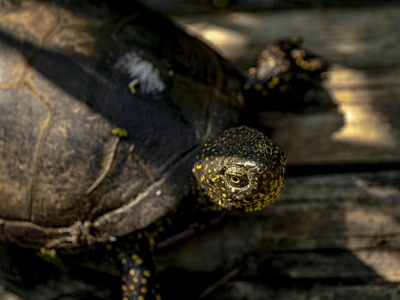
European pond turtle
Dark-shelled freshwater turtle with mottled head; basks on logs and feeds on invertebrates. Found in marshes and slow rivers. Locally threatened by wetland loss and pollution; IUCN status Near Threatened.

Levantine pond turtle
Small pond turtle with patterned plastron and head stripes; favors slow rivers and coastal wetlands. Often sympatric with Emys; vulnerable to habitat change and water pollution.
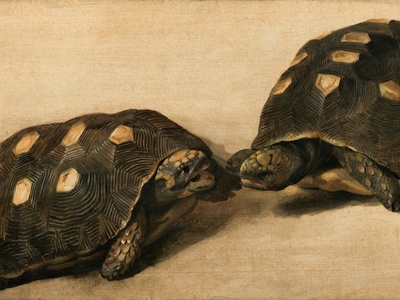
Hermann’s tortoise
Small, domed tortoise with black-and-yellow patterned carapace. Diurnal terrestrial herbivore of scrub and maquis. Locally collected and habitat-fragmented; IUCN Near Threatened.
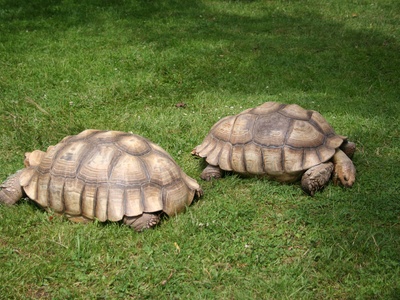
Spur‑thighed tortoise
Robust tortoise with larger, often orange tones and spur on thigh; grazes herbs and succulents. Present in warmer south; vulnerable to collection and habitat loss; IUCN Vulnerable.
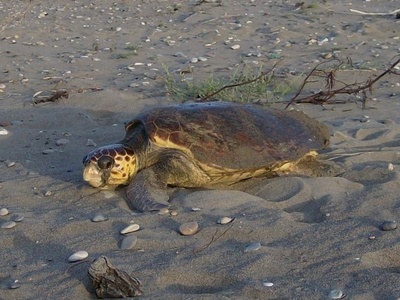
Loggerhead sea turtle
Large, reddish-brown marine turtle that nests on sandy Adriatic beaches and forages in coastal waters. Threats include fisheries bycatch and coastal development; IUCN Vulnerable in the Mediterranean.
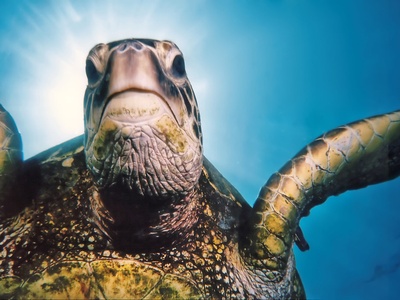
Green sea turtle
Large herbivorous sea turtle occurring offshore and nearshore; forages on seagrass and algae. Occasional nesting and regular foraging records along the coast; IUCN Endangered.
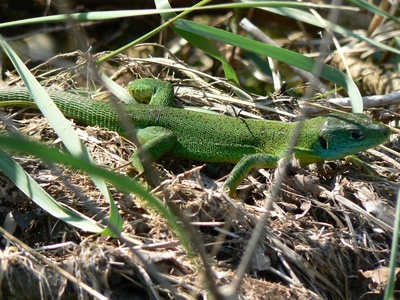
European green lizard
Bright green arboreal ground lizard with long tail; males often more vivid. Prefers humid, vegetated habitats and hedgerows. Common in suitable habitats; visible and distinctive.

Balkan green lizard
Large, slender green lizard with lateral stripes and blue ventral coloring in males. Active in sunlit rocky and grassy slopes; common in low to mid elevations.
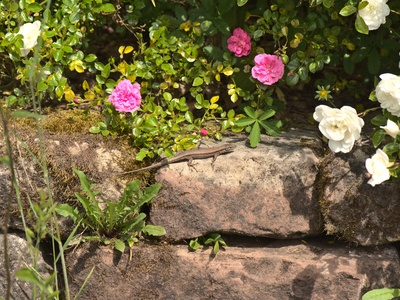
Common wall lizard
Small agile lizard with variable coloration, often on masonry and cliffs. Tolerates human environments; frequent in towns, ruins and rocky habitats across Albania.

Italian wall lizard
Robust, adaptable wall lizard often found in gardens, harbors and walls. Frequently expands via human transport; established in many coastal and urban sites.
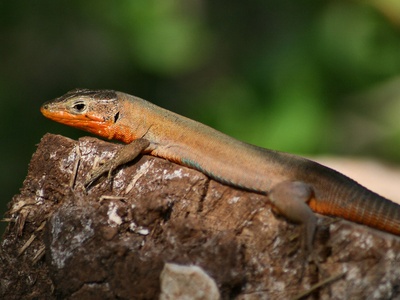
Dalmatian wall lizard
Medium-sized wall lizard with strong dorsal patterning; prefers rocky coastal slopes and karst landscapes along the Adriatic seaboard.

Snake‑eyed lizard
Slim, fast-moving lizard with immovable transparent eyelid scales; favors open, dry habitats and low scrub. Often basks on stones or bare ground.

European glass lizard
Large legless lizard (scheltopusik) resembling a snake but with eyelids and ear openings. Eats small vertebrates and large invertebrates. Prefers warm rocky and scrubby terrain.
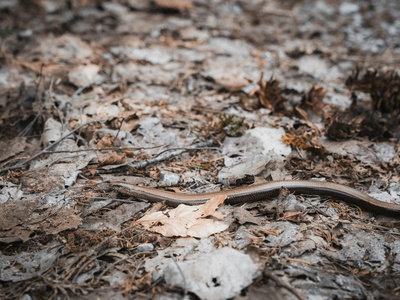
Slow worm
Legless lizard with glossy, smooth scales often mistaken for a snake; prefers cool, moist habitats and gardens. Secretive, often under debris and stones.

Ocellated skink
Cylindrical skink with smooth shiny scales and reduced limbs; favors sandy coastal habitats and dry maquis. Often secretive beneath debris and stones.

Three‑toed skink
Elongate skink with reduced limbs and sleek body, active in warm sandy soils. Found in coastal scrub and dunes, hides under litter and stones.
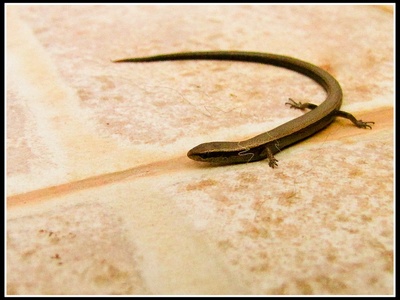
Snake‑eyed skink
Small, shiny skink with fused eyelids and slender body; often under stones and leaf litter. Common in rocky and cultivated landscapes.

Dalmatian algyroides
Small lizard with keeled scales and spotted pattern; prefers humid rocky forests and karst crevices along the Adriatic fringe.
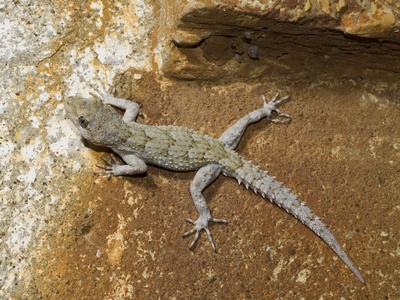
Kotschy’s gecko
Small nocturnal gecko with slender body and adhesive toes; common on stone walls, ruins and rocky habitats. Tolerant of human habitation.

Mediterranean house gecko
Nocturnal gecko often on walls and inside houses; feeds on insects attracted to lights. Introduced and synanthropic, now widely established in warmer coastal areas.
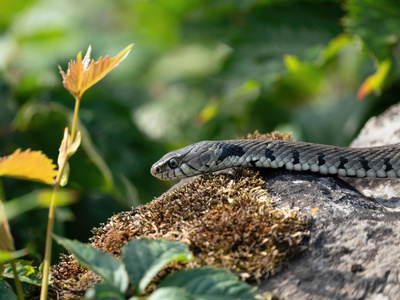
Grass snake
Olive to brown snake with characteristic collar in juveniles; nonvenomous fish and amphibian eater commonly found near water bodies.

Dice snake
Highly aquatic snake that feeds mainly on fish; grey to brown with dorsal patterning. Common along larger rivers and lakes.

Aesculapian snake
Large, slender arboreal snake often found on trees and stone walls; nonvenomous predator of small mammals and birds, favors wooded river valleys.
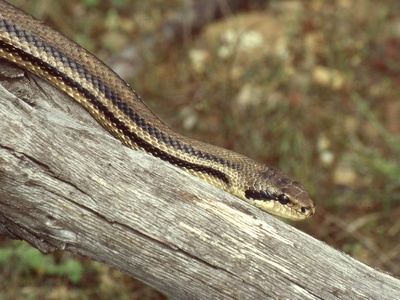
Four‑lined snake
Heavy-bodied snake with four dorsal stripes; preys on rodents and birds. Prefers warm, sheltered rocky and wooded habitats across low hills.
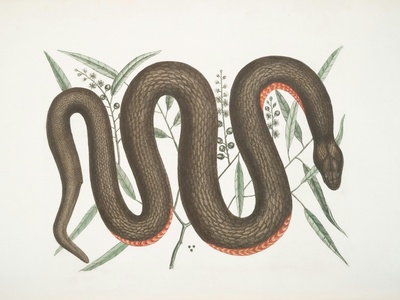
Caspian whipsnake
Very long, fast snake with glossy scales; active hunter of rodents and lizards in open habitats and cultivated land.
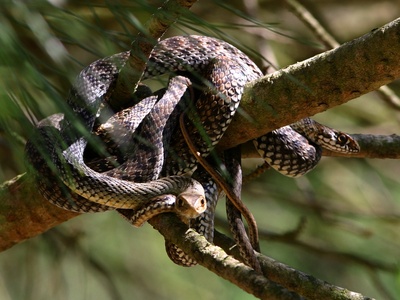
Montpellier snake
Large rear‑fanged snake with pointed head; mildly venomous to prey but usually not dangerous to humans. Prefers warm, dry, open areas.
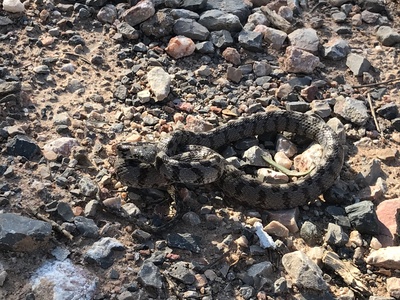
European cat snake
Nocturnal, mildly venomous rear‑fanged snake with large eyes; often found in rocky areas and ruins in warmer southern regions.
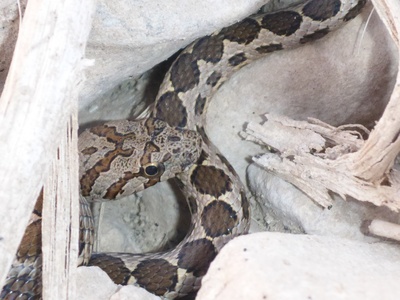
Coin‑marked snake
Slender, active snake with distinctive dorsal markings; inhabits dry scrub and agricultural landscapes in warmer areas.

Dahl’s whip snake
Slim, fast-moving snake often in open hills and scrub; preys on small vertebrates and is common in rural habitats.
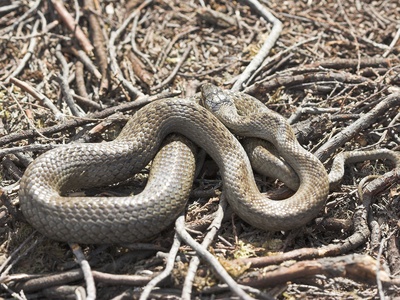
Smooth snake
Medium-sized, secretive snake with smooth scales; ambushes small reptiles and mammals in cooler, wooded uplands.

Nose‑horned viper
Distinctive viper with a small nasal horn; venomous and potentially dangerous. Prefers sunny rocky outcrops and low mountains; local populations sensitive to persecution.
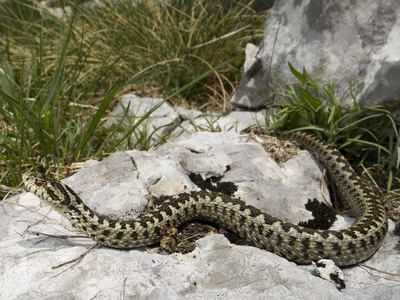
Meadow viper
Small, slender viper of high mountain meadows and steppe-like plateaus. Very localized and conservation‑sensitive; habitat-dependent and threatened in parts of its range.

Sand boa
Stout, short-bodied boa that burrows in sand and loose soil; ambushes rodents and lizards in warm sandy habitats.

Balkan worm lizard
Fossorial, legless reptile with smooth pinkish skin; lives underground in loose soils and gardens, rarely seen above ground.
